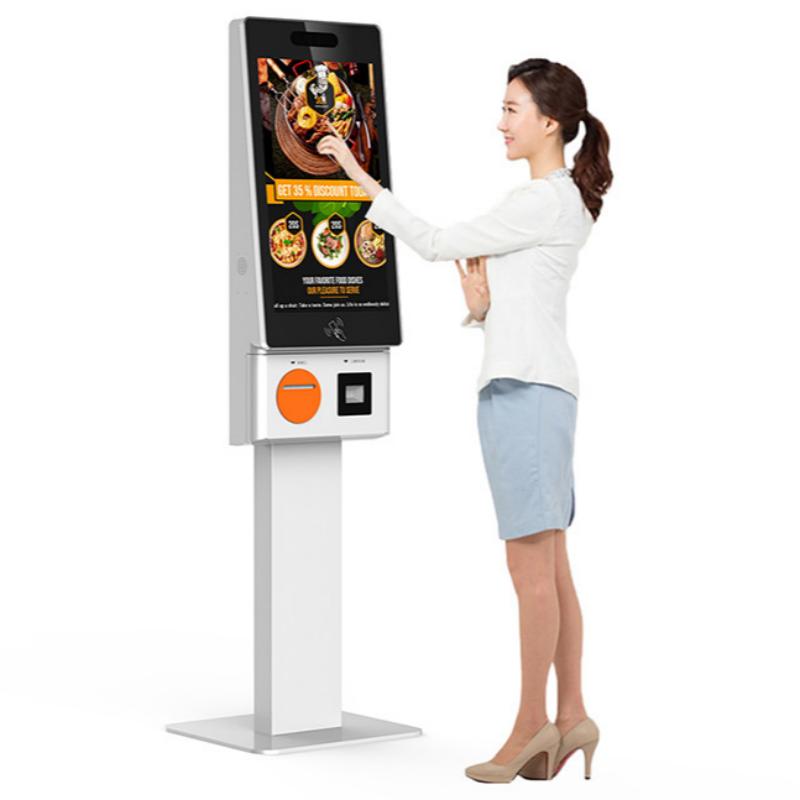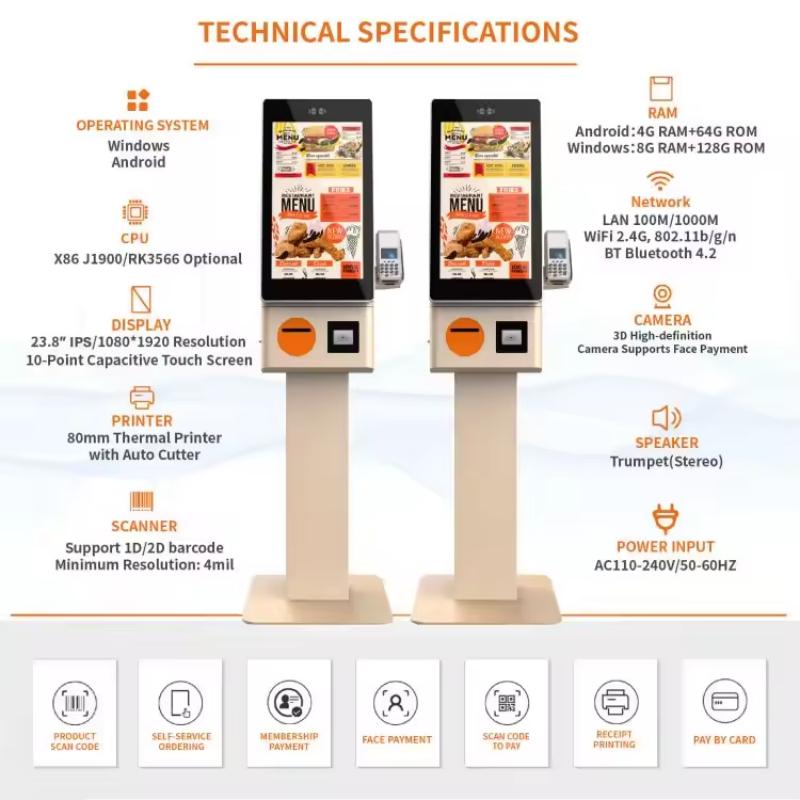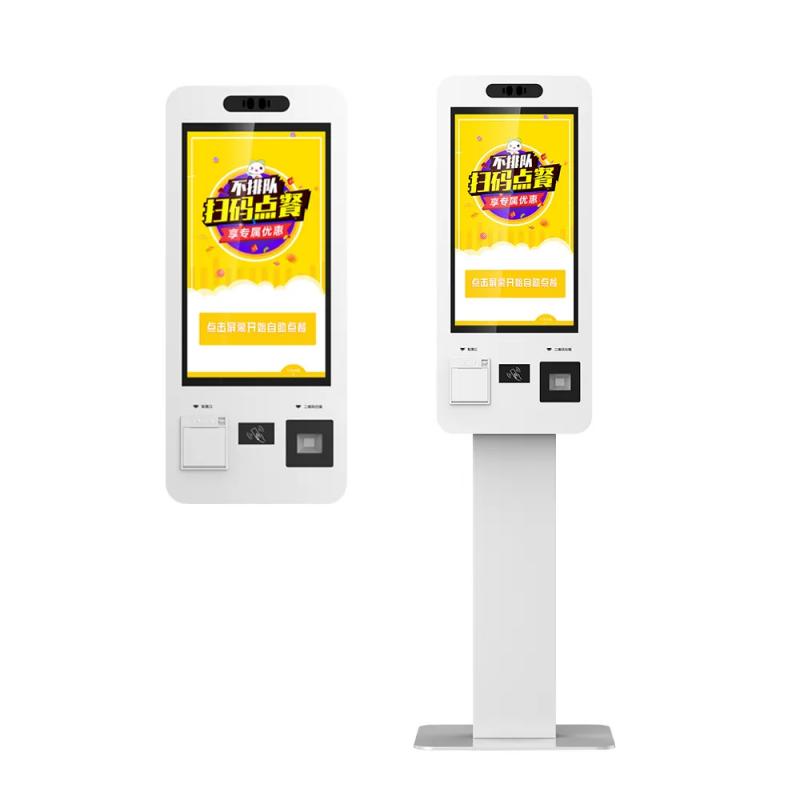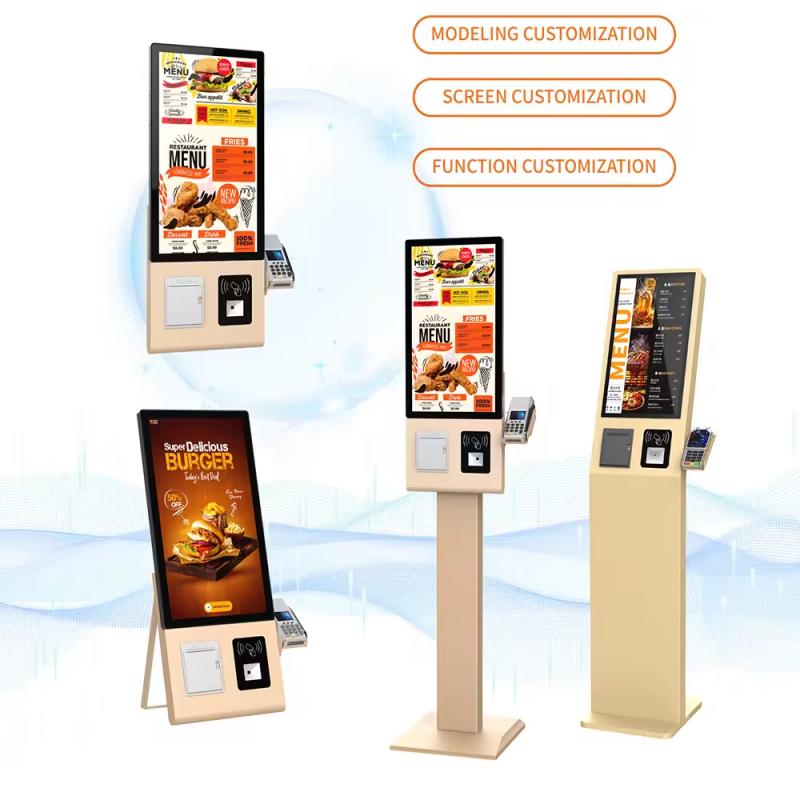
Below is a video of ordering kiosks, watch it carefully to learn more!
Learn more about our ordering kiosk cases by watching the video above, find the style you like, and customize options to improve your business efficiency.
| Component | Specifications | Manufacturing Process |
|---|---|---|
| Touchscreen Display | 15" - 32" LCD/LED, capacitive touchscreen, 1080p or 4K resolution | Screen manufacturing, touch sensor integration, assembly onto the main kiosk body |
| Processor | Intel i5/i7 or equivalent, 8GB - 16GB RAM, SSD storage | Component sourcing, processor integration, performance testing |
| Payment System | EMV card reader, NFC reader, receipt printer | Payment module assembly, integration with software, testing for compliance and security |
| Enclosure | Stainless steel or aluminum, powder-coated finish, customizable design | Metal fabrication, CNC cutting, powder coating, final assembly |
| Operating System | Windows, Linux, or Android-based systems | Software development, OS installation, UI customization |
| Networking | Ethernet, Wi-Fi, Bluetooth connectivity | Network module integration, connectivity testing, software configuration |
| Peripherals | Barcode scanner, receipt printer, speakers, camera | Peripheral assembly, integration with main board, functional testing |
| Software | Custom kiosk application, remote management software | Software development, user interface design, installation on kiosk hardware |
| Power Supply | AC 110-240V, internal power management, surge protection | Power unit assembly, electrical testing, integration with kiosk hardware |
A self-ordering kiosk is a self-service machine that empowers customers to make their own food orders directly at a touchscreen kiosk without the involvement of a restaurant cashier or waiter. Customers can customize their orders, make payments, and get receipts through the self-service kiosk.
An ordering kiosk is a self-service device that enables customers to place orders and make payments without the need for direct interaction with staff. Commonly found in restaurants, fast food chains, and retail environments, these kiosks feature touchscreens that allow users to browse menus, customize selections, and complete transactions efficiently. Ordering kiosks streamline the ordering process, reduce wait times, and enhance customer convenience by providing a quick, intuitive, and automated service experience.

Kiosks minimize the amount of staff needed to fulfill orders and empower customers to order themselves. Self-service kiosks also may enhance your restaurant's small business concept if you promote grab n' go food and drinks
Self-ordering kiosks offer numerous benefits, making them a popular choice in retail and hospitality. They reduce wait times by allowing customers to place orders independently, which speeds up service. Kiosks also improve order accuracy by minimizing communication errors and enable businesses to upsell through targeted promotions. Additionally, they enhance customer experience by providing a user-friendly interface and customization options, leading to higher satisfaction and increased sales. For businesses, kiosks reduce labor costs and streamline operations, making them a valuable investment.

Ordering kiosks are widely used in various industries, particularly in restaurants, fast food chains, cafeterias, and retail stores. Their primary application is to streamline the ordering process, allowing customers to place orders and make payments without needing to interact with staff. These kiosks feature intuitive touchscreens where users can browse menus, customize their orders, and complete transactions quickly and efficiently.
The benefits of ordering kiosks are significant. They reduce wait times, as customers can order at their convenience, which also helps manage peak hours more effectively. By minimizing human errors in order-taking, kiosks improve order accuracy, leading to higher customer satisfaction. Additionally, kiosks can be programmed to suggest add-ons or promotions, boosting average order value and sales. For businesses, they reduce labor costs by lowering the need for front-of-house staff and help streamline operations, leading to greater efficiency. Overall, ordering kiosks enhance the customer experience while providing tangible operational benefits to businesses.

The cost of ordering kiosks varies depending on factors like hardware quality, software features, customization, and additional peripherals such as payment systems or printers. On average, a basic ordering kiosk might cost between $4,000 and $8,000 per unit, while more advanced models with enhanced features and customization can range from $10,000 to $15,000. Despite the upfront investment, the return on investment (ROI) for ordering kiosks is compelling.
Ordering kiosks significantly reduce labor costs by automating the ordering and payment processes, allowing businesses to operate with fewer staff. They also enhance order accuracy, leading to fewer mistakes and waste, which translates to cost savings. Additionally, by speeding up service and reducing wait times, kiosks can increase customer satisfaction and encourage repeat visits, further boosting revenue. The ability to upsell through the kiosk interface by suggesting add-ons or promotions can also increase the average order value. Over time, these benefits typically outweigh the initial costs, making ordering kiosks a profitable investment for many businesses.

| Type | Size | Design | Customization Options | Price Range |
|---|---|---|---|---|
| Countertop Kiosk | 15" - 22" screen | Compact design for limited space | Screen size, branding, software features, payment systems | $3,000 - $6,000 |
| Freestanding Kiosk | 32" - 55" screen | Tall, standalone unit with large touchscreen | Screen size, enclosure materials, peripherals (printers, scanners) | $6,000 - $12,000 |
| Wall-Mounted Kiosk | 22" - 32" screen | Slim design for wall installation | Screen size, finish (color, materials), mounting options | $4,000 - $8,000 |
| Outdoor Kiosk | 32" - 55" screen, weatherproof | Robust, weather-resistant design | Weatherproofing, temperature control, sunlight-readable screens | $10,000 - $20,000 |
| Tabletop Kiosk | 15" - 22" screen | Portable design for tabletop use | Screen size, branding, payment system integration | $2,500 - $5,000 |
When purchasing ordering kiosks, start by identifying the specific needs of your business. Determine which type of kiosk is most suitable for your environment—whether it's countertop, freestanding, wall-mounted, or outdoor. Consider the features that are essential for your operations, such as payment processing, barcode scanning, or receipt printing. Customization is also key; ensure the kiosk can be tailored to match your branding, screen size, and software needs. Additionally, the quality and durability of the kiosk are crucial, especially for high-traffic areas or outdoor installations where the kiosks need to withstand heavy use and environmental factors.
When buying ordering kiosks, it's important to ensure that the kiosks integrate seamlessly with your existing systems, such as your POS, inventory management, and payment gateways. The user experience is another critical factor—kiosks should have an intuitive and responsive interface that is easy for customers to use. Researching the vendor’s reputation is essential; look for reviews and testimonials to ensure they provide reliable products and strong technical support. Additionally, consider the total cost of ownership and expected return on investment, balancing your budget with the potential benefits like reduced labor costs and increased sales.
What did our happy clients say?
We recently purchased ordering kiosks, and they have been a game-changer for our business. The build quality is excellent, and the interface is user-friendly. The manufacturer provided top-notch support. Highly recommend their products!
Our new ordering kiosks are performing flawlessly. They're durable, easy to use, and have significantly improved our service speed. The manufacturer's customer service was exceptional, making the entire process smooth. We highly recommend them!
We couldn’t be happier with our ordering kiosks. They’ve streamlined our operations, and the customization options were perfect for our needs. The manufacturer offered great support throughout. Highly recommend this reliable company!
These ordering kiosks have exceeded our expectations in quality and functionality. Installation was seamless, and the user interface is intuitive. The manufacturer's support team was responsive and helpful. We highly recommend them for any business!